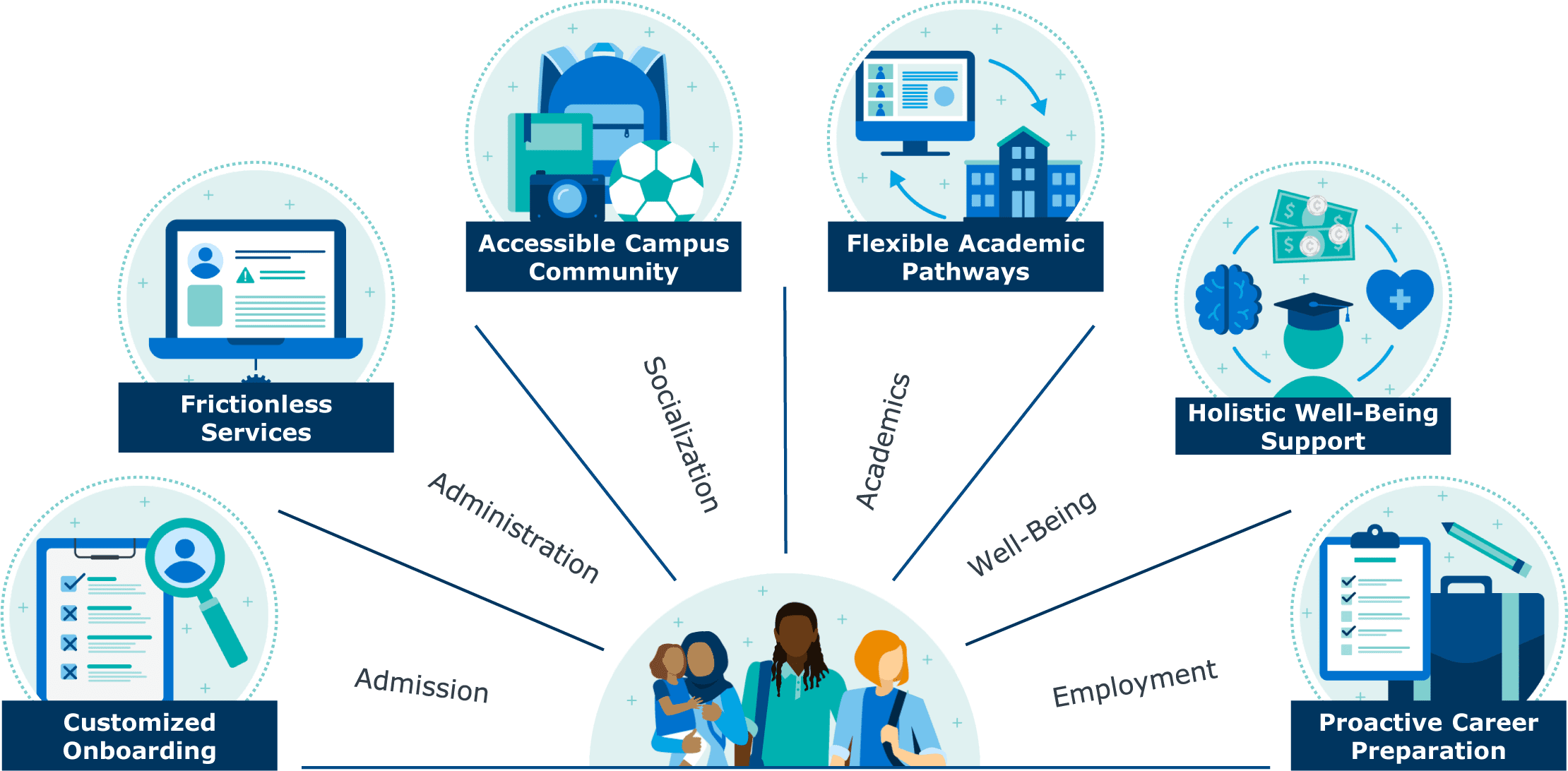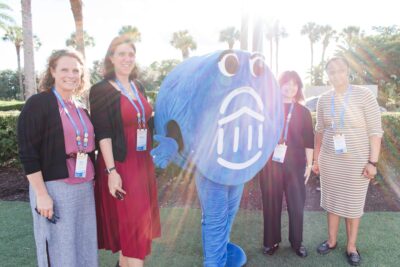Why customer service matters for community colleges
I just talked to someone in registration, and they told me to call you!
I’ve retold my story to two other people; can’t you see that I was here yesterday?
I just want to be able to do this online—why can’t I do this from my phone?
If you’ve worked at a community college, you have probably encountered at least one of these statements from a student, no matter your role. If you haven’t, take a look at your college’s reviews on Google, Niche, or social media—if there is negative feedback, it’s likely related to customer service mishaps like lost paperwork, slow responses, or unanswered questions.
...the fact is our students are consumers, and the level of customer service from enrollment management and student service offices, as well as faculty, sends a direct message to students about how much we support their success.
Community College Survey Respondent
While we might not always think of students as “customers,” the reality is that their experiences as consumers shape their expectations for how they interact with colleges. In order to design a modern student experience, colleges must understand the forces that shape student expectations long before they arrive on campus.
Seeking to understand our customer service gaps
With 20% of high school students reporting that they don’t see an ROI in college, a number that has doubled since 2019, it’s important that community colleges align themselves with consumer expectations since many students may feel less motivated to slog through drawn out processes.
EAB wanted to understand more about the extent to which those who work at community colleges are seeing modern student experiences come to life on campus, and where there still are “customer service” gaps. To do that, we surveyed over 160 community college practitioners on a national level to gather their insights about what types of customer service barriers they are seeing, the impact they have on students, and what’s stopping them from improving.
-
85%
of community college practitioners think student customer service expectations have risen since before the pandemic.
What are the features of a "modern student experience," and how do community colleges stack up?

Institutions should be thinking holistically about the student experience and seeking to understand how better efficiency and more customized support at high-impact touchpoints can enable frictionless progress through the academic journey—as well as improve student outcomes by reducing their peripheral burdens. EAB’s Modern Student Experience framework offers six pillars that institutions can use to guide their modernization conversations.
- Customized Onboarding
- Frictionless Services
- Accessible Campus Community
- Flexible Academic Pathways
- Holistic Well-Being Support
- Proactive Career Preparation.
Our survey focused on the first two pillars, Customized Onboarding and Frictionless Services since they are high touch areas with many opportunities for customer service interactions.
Customized Onboarding
Customized onboarding refers to customized interactions that consider students’ goals, interests, and preferences when welcoming them to school.
Here are the key onboarding service gaps community college practitioners reported:
- 56% of respondents said it takes their college more than a day to respond to prospective students who submit electronic requests for information.
- Only 29% of respondents said their college collects and stores information on prospective students’ interests and preferences in one place that is easily accessible to staff.
- 81% indicated that a confusing enrollment process is enough to cause a new student to not enroll.
Many of us, as consumers, would expect that if we submitted an inquiry to a business that they would contact us quickly, and the person we interact with would be able to see who we are and what services we inquired about. Quickly replying to inquiries with clear actionable steps that are tailored to the student can reduce customer service bottlenecks down the road while showing the student we care about their success.
Frictionless Services
Frictionless service refers to creating user-friendly and digital-first processes that minimize the burden of administrative tasks and refocus student attention on the educational experience. Essentially, by spending less time on clerical tasks, students can spend more time on their studies.
Our research shows that difficulty accessing the college—whether it’s reaching enrollment staff, the financial aid office, or academic advising—can be disruptive to the student experience. What’s important to remember is that the accumulation of what might seem like small inconveniences erodes student trust.
- 85% of respondents said current students have difficulty connecting with the right person at least some of the time when they have enrollment questions.
- 63% agreed that difficulty connecting with enrollment offices can cause current students to leave the institution.
- 66% think having to repeat their situation multiple times can contribute to a student leaving the college.
- 62% indicated that lapses in customer service can require students to take extra time away from work and family to resolve college issues.
We can all relate to the frustration of not being able to connect to the right person, repeating ourselves, and having to wait for appointments, especially when it disrupts our personal lives. It becomes difficult for community colleges to position themselves as a strong choice for parents and employed students when we agree that college processes disrupt those parts of students’ lives.
Watch this on-demand webinar to learn more about our survey results.
Key Recommendations
1. Invest in customer service professional development
Use both higher education and private sector customer service best practices as a reference point for how your college wants to interact with students. This might include building skills such as:
- Warm handoffs: Walking students between offices, warm phone transfers, and email introductions between offices allow for continuity of care and makes it less likely that a student will abandon the process.
- Active listening: Teaching staff how to paraphrase a student’s question or problem back to them shows the student they are heard and allows for any corrections to be made to how the staff member is understanding the problem.
- Conflict resolution: Successfully diffusing frustrated or angry students can help conflicts from escalating even further. Affirming a student’s frustration can open the door for exploring a solution together and demonstrates values of service and empathy.
2. Audit your processes for technology and workflow bottlenecks
Identifying the 2-3 most common customer service bottlenecks on your campus that cause delays and increase friction for students can make a huge difference. Use these areas as a manageable, high-impact starting point for improving customer service. This might mean asking questions such as:
- Where are students physically waiting in line? Why? What questions are they trying to answer that required them to physically come in?
- What processes take the longest and impact high volumes of students?
- What are the most common questions students are asking? Is there a way to direct these questions to a self-guidance tool?
- How much lead time do we need to introduce new policies and procedures to ensure students have time to learn about them?
- What are the busiest times of the day on campus? Do we need to flex staff time to offer more coverage during these peak times?
- Which processes have inefficient touch points or steps? [Examples: Can placement testing and advising appointments be rolled into one day? Can staff see holds and flags beyond what the student might be inquiring about and proactively bring them to the student’s attention?]
- Do we still have paper processes that could be digitized?
3. Check in with students about their experiences
Polls and quick surveys can reveal where students are hitting roadblocks and help you understand gaps in your student customer service strategy. Polls might include asking students about their interactions and can include questions about their expectations for remote services, evening hours, and response times. Here are a few ways to check in with your students:
- Kudos: Create ways for students to submit positive feedback about interactions they’ve had on campus that can be relayed to staff members.
- Exit surveys: A 1-2 question survey after a phone call, email exchange, appointment, or event can help your college pressure-check student experiences in real-time.
- Quick polls: Tools like EAB Navigate have the ability to launch brief polls, on any subject, quickly at any time of the year. These features can help gather feedback on events, such as orientation, or ask students about their communication preferences.
4. Use technology to automate processes and embrace self-guidance tools
It makes sense that students might experience delays, bottlenecks, and gaps in service when staff are backed up helping other students. One strategy colleges can employ is to leverage self-guidance tools that address common student needs. Here’s how self-guidance tools can help:
- Make sure your “digital front door” is approachable and easy to navigate: We might not think of websites as a customer service tool, but they are often the first customer service interaction that students have with your college.
You can read more about students’ expectations of college websites in EAB’s Recruiting Gen P insight paper.
- Tech-first processes: Using technology to connect students to checklists, resources, deadlines, and their support team means students don’t have to “hunt” for information. Navigate360 is one way to create this common workspace so students can access what they need, on their own time. Navigate360 also enables a seamless staff and faculty connection to make it easier to share notes, send alerts and more effectively serve students.
Read the case study to learn how one partner increased faculty buy-in of student success technology by 11% in one academic year.
5. Use data insights to proactively anticipate what students need
Use student success technology to create a 360-degree profile of students that will help you understand who needs proactive outreach from the college. Integrated analytics tools that monitor population health and identify which students may need extra support allow your teams to proactively deliver interventions that help students succeed and demonstrate that you care about their progress.
This includes:
- Peak times: Track when the college has high traffic by looking at things like appointment data to anticipate staffing needs during busy times.
- Personal characteristics: By collecting key information about students, you can proactively offer them support rather than waiting for them to request it on their own. For example, if you know which students are parenting, you can anticipate they may need childcare assistance and send them resources before the semester starts.
- Proactive reminders: A trait of great customer service is clear, proactive communication. By sending students small reminders or “nudges,” we give them the on-ramp they need to complete tasks and time to seek help if they need it.
Take Data Management A Step Further to Improve Customer Service
Unlocking and interpreting the student data from different sources across campus is crucial for exceptional service. However, challenges like data accuracy and data integration make this task difficult to achieve. EAB’s Edify resolves this by centralizing multiple data sources (such as your LMS, SIS, and CRM data) into a unified, trustworthy view and provides actionable insights so you can serve students more strategically at every stage of the lifecycle.
EAB Partner Wins
We know that technology can help provide smoother customer service, and EAB partner survey respondents reported significant wins in streamlining services for students.
EAB partners
-
6%
More likely to have wait times under 24hrs for academic advising appointments during peak registration periods
-
37%
More likely than non-EAB partners to report online appointment scheduling is easy for students
Non EAB partners
-
2x
Are twice as likely to think insufficient technology is a barrier to improving customer service
-
7%
More likely to believe slow communication from the college causes new students to stop the enrollment process
Conclusion
As you think about the recommendations outlined in this blog, you will still need technology to help achieve your customer service goals.
EAB’s Navigate360 CRM allows for students, staff, faculty, and administrators to connect in a shared, tech-enabled workspace that improves communication, creates milestones, and allows for transparency into a student’s interactions with different people and offices. This transparency, coupled with embedded self-guidance tools, creates a strong customer service foundation.
To learn more or request a demo, fill out the quick form below.
Ready to find out more?
Fill out the form and someone from our team will follow up.

More Blogs

Four signs it’s time to break up with your student CRM

Three lessons from 1,200 student success leaders on higher ed’s future
